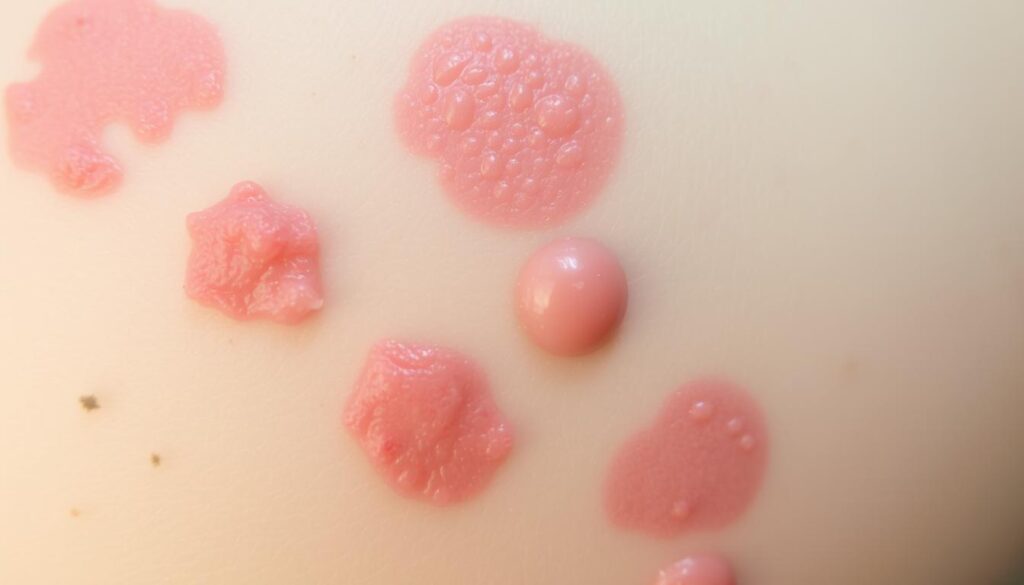Contact dermatitis can disrupt your daily life. It’s a skin reaction triggered by irritants or allergens. This condition causes itching and discomfort, often showing up as red, swollen, or cracked skin1.
Everyday substances can harm your skin’s protective barrier. Irritant contact dermatitis is the most common type. It’s often caused by chemicals like bleach, solvents, or harsh hair products1.
Some people are more likely to get these reactions. This includes those working in healthcare, cleaning, or construction1.
Understanding contact dermatitis helps prevent and manage symptoms. Recognizing triggers and taking protective steps can reduce painful skin reactions1.
Key Takeaways
- Contact dermatitis can last up to 4 weeks if the trigger is not removed
- Common irritants include chemicals, plants, and personal care products
- Symptoms vary from itching to blistering and skin thickening
- Some occupations have higher risks of developing contact dermatitis
- Prevention is key in managing this skin condition
What is Contact Dermatitis?
Skin conditions can be complex and frustrating. Contact dermatitis is a common skin problem that causes inflammation and discomfort. Learning about this condition can help you manage and prevent it better.
Defining the Skin Reaction
Contact dermatitis is skin inflammation caused by touching specific substances. It happens when your skin reacts to irritants or allergens2. Dermatologists recognize two main types: irritant contact dermatitis and allergic contact dermatitis.
Types of Contact Dermatitis
- Irritant Contact Dermatitis: The most common form, occurring when harsh substances damage your skin’s protective layer23. Irritants like acids, soaps, and chemicals can trigger this reaction.
- Allergic Contact Dermatitis: An immune system response to specific allergens that causes skin inflammation2. This type can develop over months or years of exposure2.
Symptoms to Watch For
Spotting contact dermatitis early helps manage it better. Common symptoms include:
- Intense itching
- Red, streaky rash
- Weeping blisters
- Warm and tender skin areas
- Scaling or crusting
“Contact dermatitis often affects areas directly exposed to irritants, such as hands, face, and neck”2
People with eczema or sensitive skin may get contact dermatitis more easily3. If you have ongoing or bad allergic reactions, see a doctor for proper diagnosis and treatment.
Common Causes of Contact Dermatitis
Contact dermatitis triggers can disrupt your daily life. Knowing these causes helps prevent and manage this uncomfortable skin condition. Various substances and factors can lead to painful skin reactions.
Allergic Reactions to Substances
Allergic contact dermatitis happens when skin becomes sensitive to specific allergens. Common triggers include:
Irritants That Can Trigger Dermatitis
Some products can harm your skin’s protective barrier. Irritant contact dermatitis often affects people exposed to harsh substances4.
| Workplace Irritants | Household Irritants |
|---|---|
| Solvents | Detergents |
| Bleach | Soaps |
| Chemical cleaners | Hair products |
Environmental Factors Contributing to Symptoms
Your skin’s reaction can be influenced by various environmental triggers. Excessive hand-washing may worsen dermatitis symptoms.
Prolonged exposure to chemicals can also intensify skin reactions. Contact with certain fabrics or metals might trigger dermatitis5.
Professional environments like healthcare, hairstyling, and mechanics often present higher risks of contact dermatitis due to frequent exposure to potential irritants4.
Effective Treatments and Management Strategies
Contact dermatitis management requires a holistic approach to skin health. Your treatment plan will focus on finding triggers and using targeted topical treatments. Prescription-strength corticosteroids and calcineurin inhibitors can provide significant relief for stubborn symptoms6.
Over-the-counter options are vital for managing contact dermatitis. Cool wet compresses and barrier creams can soothe irritated skin7. Oral antihistamines might help control itching when the rash becomes uncomfortable6.
Lifestyle remedies like moisturizing and using medicated products can offer additional comfort6. Professional help is needed when symptoms persist or worsen. Dermatologists can perform patch tests to identify specific allergens6.
Seek medical advice if your rash is severe, widespread, or doesn’t improve within three weeks8. Wearing gloves, avoiding irritants, and keeping skin moist can prevent future outbreaks7.
FAQ
What exactly is contact dermatitis?
What are the most common symptoms of contact dermatitis?
What are the most frequent triggers of contact dermatitis?
How can I treat contact dermatitis at home?
When should I see a doctor about my contact dermatitis?
How can I prevent contact dermatitis?
Is contact dermatitis contagious?
Source Links
- Contact dermatitis – Symptoms and causes – https://www.mayoclinic.org/diseases-conditions/contact-dermatitis/symptoms-causes/syc-20352742
- Contact dermatitis – https://www.mountsinai.org/health-library/diseases-conditions/contact-dermatitis
- What Is Contact Dermatitis? – https://www.healthline.com/health/contact-dermatitis
- Contact dermatitis: MedlinePlus Medical Encyclopedia – https://medlineplus.gov/ency/article/000869.htm
- Contact dermatitis – https://www.nhs.uk/conditions/contact-dermatitis/
- Dermatitis – Diagnosis and treatment – https://www.mayoclinic.org/diseases-conditions/dermatitis-eczema/diagnosis-treatment/drc-20352386
- What is contact dermatitis and how is it treated? – https://nationaleczema.org/eczema/types-of-eczema/contact-dermatitis/
- Diagnosis and Management of Contact Dermatitis – https://www.aafp.org/pubs/afp/issues/2010/0801/p249.html
